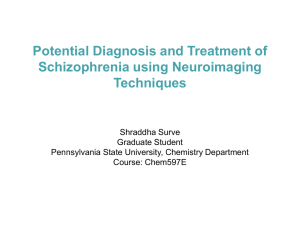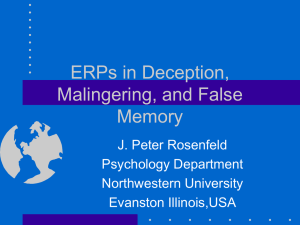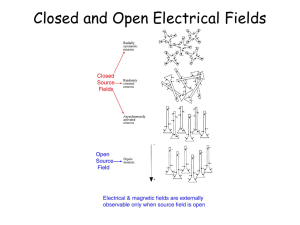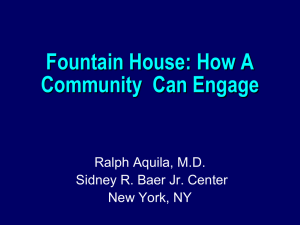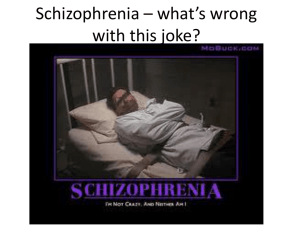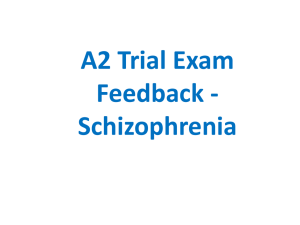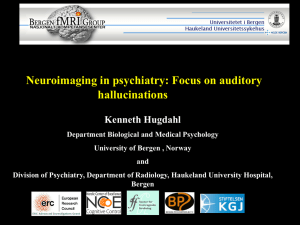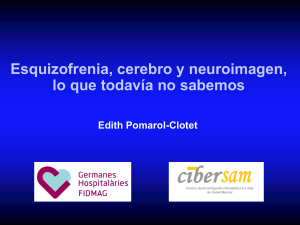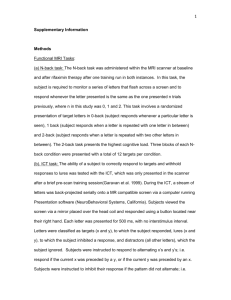Neurobiology of Schizophrenia - Olin Neuropsychiatry Research
advertisement
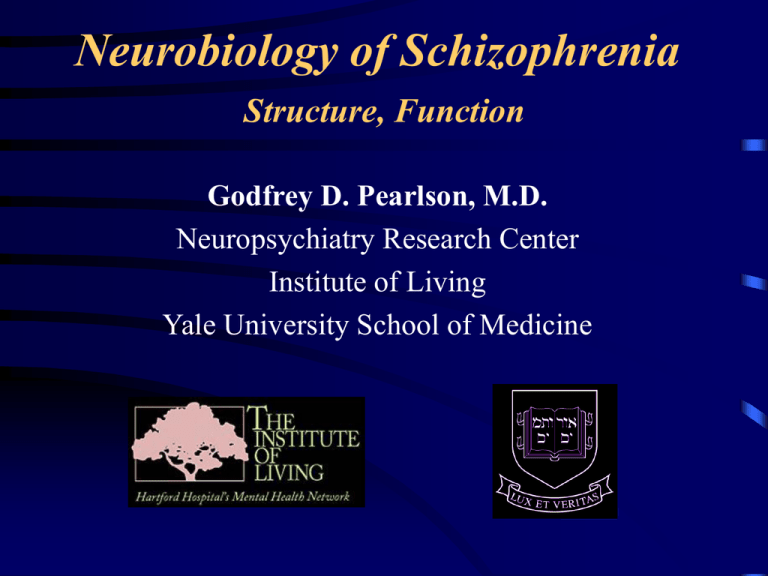
Neurobiology of Schizophrenia Structure, Function Godfrey D. Pearlson, M.D. Neuropsychiatry Research Center Institute of Living Yale University School of Medicine Figure 1. Right and left cerebral hemisphere of the same Down Syndrome brain. Note its globular configuration and steeply sloping occipital pole. In this brain, the superior temporal gyrus is small bilaterally. Photographs courtesy of Yakovlev collection, AFIP Figure 2. Schizophrenia. Lateral aspect of left hemisphere showing deviations of the temporal sulcogyral pattern. Disease Genes Viral Infection Environmental Toxins Peri-natal/Birth Complications TRIGGERS: Environmental Stress Biological Factors Drug Use Biological Vulnerability Structure Biochem Function Age 0 Neurol + Cognitive Deficits 5 Premorbid Early Negative Symptoms Weak Positive Symptoms 12 15 Early Prodrome Emerging Psychotic Symptoms 18 Late Prodrome 21 GENE CELL SYSTEM BEHAVIOR Schizophrenia – The Temporal Lobe First Psychotic Episode Patients • • • No confounds of chronic illness Can compare schizophrenia patients with those with affective (mood) disorder (AFF) psychosis (85% to 90% manic psychosis) Similar findings in unaffected 10 relatives Auditory Hallucinations & Temporal Lobe Identifying Small Fibers: The Arcuate Fasciculus Symptoms suggestive of frontal lobe dysfunction • • • • • • • • Emotional dullness Impaired judgment Poor initiative, motivation, drive Lack of insight Difficulty in planning Impaired problem-solving/abstract reasoning Decreased concern for personal hygiene Social withdrawal The Dopamine Hypothesis and Schizophrenia D2 receptor occupancy and symptom response IN-VIVO DA RELEASE Multiple Dopamine Receptors Dopamine and other Neurotransmitters GENE CELL SYSTEM BEHAVIOR Basic Auditory Oddball Paradigm 80% 10% 10% One of These Things (Is Not Like The Others) Patients are as quick and accurate as healthy subjects Auditory Oddball, P300 EventRelated Potential (ERP) Amplitude smaller in SZ. This Response is There For a Reason……….. NSD performance in schizophrenia vs healthy controls P3 FACTS Auditory Oddball P3 – Activates multiple cortical regions. – Pattern shows strong heritability. – Abnormal in many SZ patients, (but not specifically abnormal in SZ). --SZ patients can perform the task well. --A well-recognized endophenotype. --Minimally influenced by illness stage or by antipsychotic medication. P300 Manifests Both As An fMRI Activation Pattern And As An ERP 1. fMRI Auditory Oddball Study Kiehl et al. N=100 Study of AO Task in HC NeuroImage 2005 Areas of significant activation (10-10 voxel-wise corrected for targets vs standards) SZ vs Controls Controls N=18 Schizophrenia N=18 Areas of activation for target processing. Schizophrenia patients exhibit less activation in multiple areas All illuminated voxels are at p<0.001, corrected for multiple comparisons. Auditory Oddball Task with fMRI hl HEALTHY VOLUNTEERS N=43, group-matched SCHIZOPHRENIA N=20 Auditory Oddball fMRI Task SZ and 1o Relatives vs Controls IS THE DIFFERENT BRAIN RESPONSE IN PATIENTS RELATED TO GENETIC DIFFERENCES ? P<0.0006 HEALTHY PATIENTS We Typed 326 SNPs from 222 Genes, on an Illumina Chip Collaboration with Gualberto Ruano Liu et al. Human Brain Mapping in press Extracted fMRI Component BOLD activation pattern best separating SZ patients from healthy controls (p<0.006) Extracted fMRI Component What regional fMRI BOLD activation pattern best separated SZ patients from healthy control subjects? (p<0.006) Negative Differences. • Superior frontal gyrus BA6 • Medial frontal gyrus BA6 • Superior temporal gyrus BA38 Positive Differences. • • • • • • • Lingual gyrus BA 18, 17 Precuneus BA 7, 19 Cuneus BA 17, 18, 19 Superior parietal lobule BA 7 Fusiform gyrus BA 18, 19 Post central gyrus BA 5, 7 Interior occipital gyrus BA 17, 18 Gene Findings Genetic component best explaining activation in the fMRI component (p<0.001). ** * * * * Schizophrenia Symptoms Were Related to Both fMRI and Genetic Data 2. ERP Auditory Oddball Study P300 Has 2 Major Components P3b P3a, Target ERP components (Pz) n200 -6 n200 -4 -2 uV 0 early p300 2 4 6 late p300 late p300 8 10 12 early p300 average ERP -200 0 200 400 ms 600 800 1000 The correlation between the target p300 and SNP component = 0.55 (p<0.0002). BRAIN SUBJECTS PROBE ANALYSIS BRAIN DATA GENE DATA rs1466163 AADC rs 2429511 ADRA2A rs3087454 CHRNA7 rs821616 DISC 1 rs 885834 CHAT rs1355920 CHRNA7 rs4765623 SCARB1 rs4784642 GNAO1 rs 2071521 APOC3 rs7520974 CHRM3 PARALLEL ICA SCHIZOPHRENIA VS NORMAL CONTROLS The paired ERP component responding to novel stimuli -10 -5 uV 0 5 10 NORMAL CONTROLS 15 PARALLEL ICA 0 ms 500 1000 P3a -2 0 2 4 6 P3b 0 ms 500 rs1800545 ADRA2A rs7412 APOE rs1128503 ABCB1 rs6578993 TH rs1045642 ABCB1 rs2278718 MDH1 rs4784642 GNAO1 rs521674 ADRA2A rs1800545 ADRA2A rs7412 APOE rs1128503 ABCN1 rs6578993 TH rs1045642 ABCB1 rs2278718 MDH1 rs4784642 GNAO1 rs521674 ADRA2A The paired ERP component reponding to target stimuli uV TASK 1000 Conclusions : “Imaging Genetics” •Aim: to meld genetic & brain imaging findings to elucidate role of genetic variation in neuro-psychiatric disorders, or to associate normal population differences in cognition or behavior with structural/functional brain imaging measures. •Instantiation: Once a potential neuropsychiatric disorder risk gene has been identified, a useful strategy is to explore if normal gene variants have any influence on normal brain structure/function. •This helps provide a context for how altered function at a genetic level may play out at a brain system level (a la Weinberger). THANK YOU !
